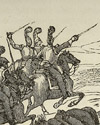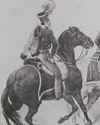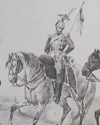19th Century´s militar history in the Basque Country
The liberal cavalry
 Right from the start of the war, the government placed great emphasis on increasing the cavalry, which consisted of five line and eight light regiments, a single squadron in Madrid, and four Royal Guard regiments. Following a Royal Decree in November 1835, each regiment contained 800 men and approximately 700 horses.
Right from the start of the war, the government placed great emphasis on increasing the cavalry, which consisted of five line and eight light regiments, a single squadron in Madrid, and four Royal Guard regiments. Following a Royal Decree in November 1835, each regiment contained 800 men and approximately 700 horses.
In October 1836, all useful horses in Madrid, La Mancha and Cuenca were confiscated for use by the Liberal cavalry, to prevent them from falling into Carlist hands.
 In December 1837, the cavalry arm had over 10,600 men and around 9,000 horses. The Liberal authorities confiscated horses again in October 1838 and in January of the following year until they had obtained an additional 4,000 horses.
In December 1837, the cavalry arm had over 10,600 men and around 9,000 horses. The Liberal authorities confiscated horses again in October 1838 and in January of the following year until they had obtained an additional 4,000 horses.
The cavalry was not the decisive military corps in this war because the complications of its main setting made manoeuvring difficult. Nonetheless, some of the main actions of the cavalry are described below. This arm was used most effectively in Navarre.
 The first time that the Royal Guard faced the Carlist cavalry was in July 1834, in Viana, and it was defeated in an offensive led by Zumalacárregui himself. After losing more than 200 horsemen, the Liberals were forced to take refuge in Logroño.
The first time that the Royal Guard faced the Carlist cavalry was in July 1834, in Viana, and it was defeated in an offensive led by Zumalacárregui himself. After losing more than 200 horsemen, the Liberals were forced to take refuge in Logroño.
At the Battle of Mendigorria, the largest battle in terms of numbers, the superiority of the Liberal cavalry was fundamental in shifting the balance in its favour.
Lastly, the superiority of the Liberal cavalry over its Carlist counterpart also played a role in the failure of the Carlist expeditions across the Peninsula - that led by Gómez in 1836 and the Royal Expedition of the following year.

